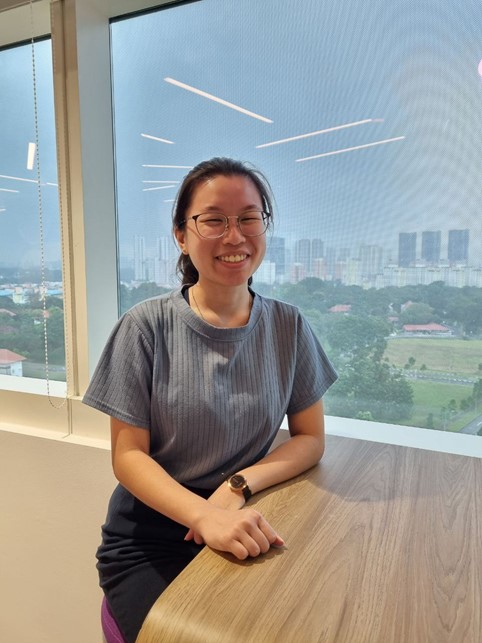 Associate Averie Low. (Photo: HTX)
Associate Averie Low. (Photo: HTX)
Coming into the Biometrics and Profiling Centre of Expertise (B&P CoE), Averie was equipped with a deep knowledge of fingerprints—a fingerprint ‘expert’ of sorts. After all, during her final year project as an undergraduate at the National University of Singapore, she researched on an extremely niche area of fingerprints—the development of wetted latent fingerprints.
You might think wetted fingerprints refer to your fingers being sweaty and producing a “wetted” print. However, the reality of wetted fingerprints could be a lot more nefarious. Wetted fingerprints can be formed when criminals try to hide key evidence from a crime scene by dumping it into a body of water. When the suspect’s fingerprints are submerged in water and “wetted”, it makes it significantly more difficult for traditional fingerprinting methods to accurately identify them.
“What I was researching on was how to develop and preserve fingerprints despite it being submerged in water, so that even if someone tries to get rid of forensic evidence, we will still be able to recover the fingerprints for identification,” Averie explained.
With her deep subject matter expertise in life science and forensic science, she took a bold move and chose to join the B&P CoE as an Associate under HTX’s Associates’ Programme.
“I chose to join the B&P CoE as I could learn other forms of biometrics while also applying what I learnt about fingerprinting from university. I also enjoy creating prototypes that make a real difference in people’s lives, especially when I get to see the tangible impact they’ve made firsthand,” Averie shared.
However, the creation of prototypes comes with its own set of challenges—namely, that Averie needs to have knowledge of various other sciences.
“For example, if I’m building a novel fingerprint scanner, other than knowing the biometric makeup of a fingerprint, I also need to know certain concepts from physics to make a decent prototype of the scanner,” she explained.
As Averie soon found out, learning new sciences from scratch is no easy task.
"I chose to join the B&P CoE as I could learn other forms of biometrics while also applying what I learnt about fingerprinting from university."
Mastering new frontiers
Recalling her initial rocky start at B&P, Averie shared, “Coming from a Life Science and Forensic Science background, my studies were quite different from the work done in B&P. For example, I wasn’t very familiar with computer science and engineering, which made it more difficult for me to design and build prototypes.”
While it would be daunting for most of us to quickly learn skills from a different technical discipline, Averie saw this as more of an opportunity to learn something new. That being said, she admits that acquiring these new skills was not easy.
“I attended many workshops and courses to strengthen my technical skills, like GovTech’s part-time Data Champion Bootcamp,” she shared.
There was also a new skill Averie was not expecting to learn as a biometrics engineer—the pitching of projects. While you might associate pitching with marketing or business, engineers also have to effectively present their novel research and projects to potential stakeholders and convince them why their projects matter.
“As part of the Associates’ Programme, I was given the opportunity to attend courses on how to pitch my ideas successfully. For me, that meant learning how to communicate more clearly with stakeholders. I think pitching is relevant in every job, as it’s about convincing stakeholders of your ideas,” she shared.
From theory to practice
Of course, learning new skills is one thing. Applying them to your work is another.
As an Associate, Averie managed to further build up her technical expertise through Research and Development projects like the novel fingerprint scanner. This fingerprint scanner is different from the typical fingerprint scanner you might find at immigration, as it views the “layers” of a finger rather than just the outermost layer of the skin on a finger.
If you have come across someone who has failed to get fingerprint scanned at immigration, it is most likely because conventional fingerprint scanners are unable to pick up “worn fingerprints”—or when there are no ‘visible’ prints on our fingers.
“Since the new scanner can view multiple fingerprint layers, those details might give us enough characteristics to make out the identity of the person,” Averie shared.
Journeying into uncharted territory
In the future, Averie wishes to conduct novel research on other forms of biometrics, not just fingerprints.
Luckily, the Greenfield project provides the perfect avenue for her to do so. The Greenfield project is the ‘finale’ of the Associates Programme, where Associates create their own challenging and innovative projects.
“For my Greenfield project, I’m planning on resolving some common challenges that arise while implementing iris recognition. While there’ll definitely be challenges along the way, I’m keen on tackling them head-on and diving into a future full of exciting possibilities,” she passionately shared.
Keen on levelling up your science and tech skills? Apply for HTX’s Associates’ Programme here. Applications are now open and will close on 30 April 2024.
We are always seeking inquisitive and innovative individuals to co-create extraordinary solutions with us.
Join us to be at the forefront of the finest tech capabilities in the field! Join Us

